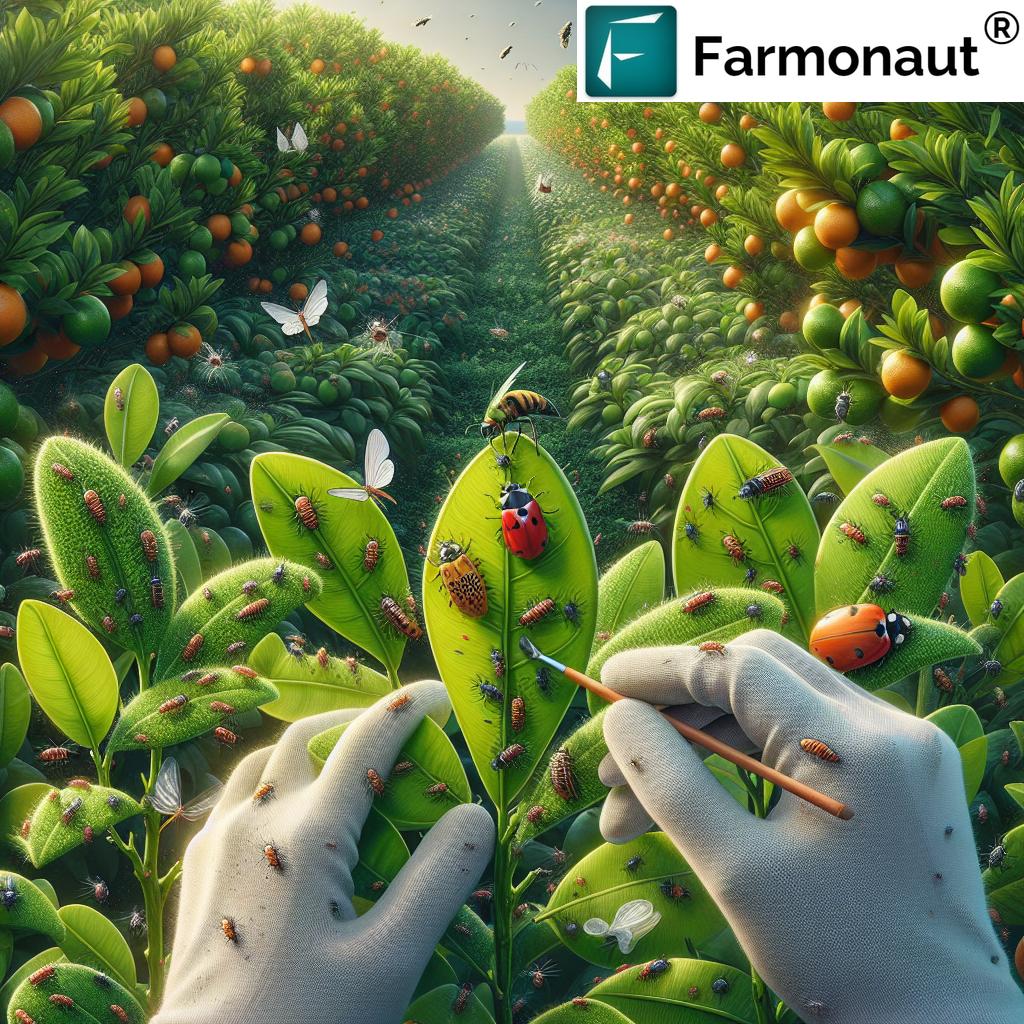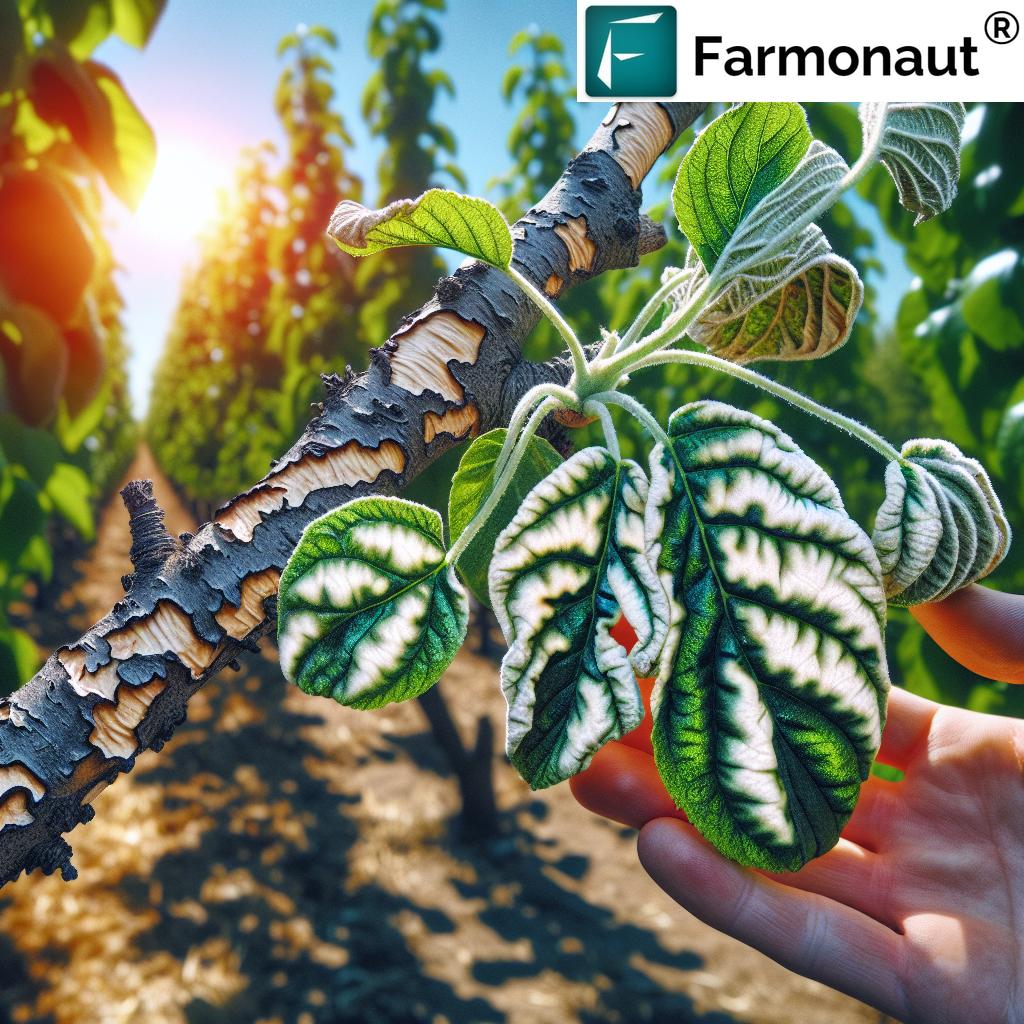How to Get Rid of Aphids on Citrus Trees Fast: The Complete Guide to Protecting Your Citrus Orchard
“Aphids can reproduce up to 12 times per season, making early citrus tree intervention crucial for effective control.”
Understanding Aphids and Their Impact on Citrus Trees
Aphids are tiny, soft-bodied insects found nearly everywhere in the world, but they are especially problematic in citrus orchards. Among the most common and damaging pests affecting citrus trees worldwide, aphids cause significant crop losses when not managed effectively. Understanding their biology, feeding behavior, and the health impact on citrus trees is crucial for successful citrus pest management strategies.
Aphids vary in color—green, yellow, black, brown—and typically measure 1-4 mm. Most aphids attacking citrus are green or black, blending with the leaves, shoots, and new growth. Their bodies are pear-shaped, and you might spot both winged and wingless forms depending on season and population pressure.
Aphids feed by piercing the plant tissues and extracting sap from the phloem, leading to:
- Weakened trees and reduced growth
- Distorted or curled new shoots and leaves
- Stunted growth and reduced fruit yields
- Transmission of plant viruses
- Formation of sticky honeydew on plant surfaces—ideal ground for sooty mold and fungal growth
One of the biggest indirect damages aphids cause is through the excretion of honeydew. This sticky residue promotes sooty mold on citrus leaves, hindering vital processes like photosynthesis. When sooty mold covers leaf surfaces, the tree’s ability to produce food is compromised, which can severely impact the overall health of your orchard.
How Aphids Invade Citrus Trees and Why Early Detection Is Vital
Aphids primarily target tender new shoots and young leaves. These tissues are soft and rich in nutrients, making them ideal food sources. As a result, rapid aphid reproduction can injure large sections of a tree quickly—sometimes within a single week. A heavy infestation can reduce both fruit size and overall yield.
Aphids also serve as vectors, transmitting viruses from plant to plant. The risk of disease spread increases in orchards with persistent aphid problems, making swift aphid control not only beneficial for immediate health but integral to long-term orchard success.
Do you manage commercial citrus orchards or wish for satellite-powered, real-time pest monitoring? Check out our advanced Blockchain-Based Product Traceability solution, which not only improves transparency in your supply chain but also keeps you updated on crop health using our AI and satellite tools.
Recognizing Aphid Infestation Signs & Early Detection
The key to effective aphid management is early detection. Aphids are often most visible on the undersides of leaves and on new shoots. Knowing what to look for allows timely intervention, preventing population explosions and serious damage.
Primary Aphid Infestation Signs on Citrus Trees
- Distorted or Curled Growth: New leaves and shoots appear twisted, curled, or stunted. This often corresponds to heavy feeding.
- Sticky Honeydew Presence: Aphids excrete a sticky substance on leaves, fruit, and branches. This sweet residue attracts ants and other insects.
- Sooty Mold Development: Black, sooty, or grayish fungal growth on the sticky surfaces. This blocks sunlight and impedes photosynthesis.
- Visible Aphid Clusters: Colonies of tiny pear-shaped insects on the tender buds, undersides of leaves, and growing tips.
- Ant Activity: Increased presence of ants feeding on honeydew serves as a secondary pest warning.
Aphids can be green, yellow, black, or brown. Their small size means infestations may go unnoticed until significant damage occurs. Regular monitoring and early detection are absolutely vital. For professional growers managing dozens or hundreds of trees, our Farmonaut Crop Plantation/Farm Advisory App offers a streamlined, satellite-backed solution to quickly pinpoint stressed trees potentially affected by aphid infestations.
Concerned about the impacts of aphid infestations on crop insurance or loan applications? Our Crop Loan and Insurance Verification Services leverage satellite-based monitoring—reducing fraud and ensuring quick, transparent verification for financial institutions and growers worldwide.
“Ladybugs can eat up to 50 aphids a day, serving as powerful natural predators in citrus orchards.”
Integrated Pest Management for Citrus: An Overview
Integrated Pest Management (IPM) for citrus combines multiple pest management strategies—cultural, biological, chemical, mechanical, and preventive—to manage aphid populations effectively while protecting tree health and minimizing environmental impact.
IPM is not a single method—rather, it’s an ongoing, adaptive approach that uses the least disruptive interventions first. The focus is on recognizing pest threats, implementing natural and organic aphid control methods, and only using stronger controls (like chemicals) when absolutely necessary.
Four Pillars of Integrated Pest Management for Citrus:
- Cultural Controls: Good orchard practices that create an environment less favorable to aphids.
- Biological Controls: Harnessing natural predators of aphids and beneficial organisms found naturally or introduced in the orchard.
- Chemical/Organic Methods: Using oils, soaps, or targeted insecticides with minimal non-target impact; emphasizing organic where possible.
- Mechanical/Physical Actions: Direct interventions such as pruning or water jets.
The combination of these methods forms a robust, adaptive, and environmentally sensitive system for managing aphids on citrus trees.
Large-scale citrus producers: Efficient orchard monitoring and fleet/resource management are critical for timely pest control. Discover the Farmonaut Fleet Management Solution to improve logistics, response time, and operational efficiency in citrus orchards.
Cultural Controls & Best Practices to Reduce Aphid Populations
Cultural controls for aphids focus on making the orchard less hospitable to aphids and more resilient overall. These are the foundation of preventing aphid infestations and should be routine throughout the season.
Essential Cultural Practices
- Regular Pruning: Remove heavily infested, twisted or curled branches and leaves, focusing on new growth where aphids cluster. Pruning boosts air circulation and limits aphid strongholds.
- Balanced Fertilization: Provide nutrients according to soil tests. Excessive nitrogen can create lush, tender new growth that attracts aphids. Aim for slow, even growth that’s less susceptible to infestations.
- Consistent Watering: Avoid stress—stressed trees (from drought or overwatering) attract aphids. Irrigate deeply but infrequently, matching the season’s needs.
- Remove Weeds and Wild Hosts: Weeds and alternate hosts can harbor aphid populations and pests; keep the orchard floor clean.
Strategic removal of heavily infested shoots and branches directly reduces aphid populations and decreases the risk of virus transmission.
Healthy, stress-free trees not only recover faster from aphid damage but are also less attractive to pests. For smart monitoring of plant stress (often the first sign of trouble), our Farmonaut real-time crop health monitoring tools use multispectral satellite images to help growers track vegetation health, NDVI, and even soil moisture. You can learn more about this on our Agro-Admin App product page.
Biological Control of Aphids: Harnessing Nature
Biological control of aphids is the heart of any sustainable integrated pest management for citrus. This method utilizes natural predators of aphids, such as lady beetles, hoverflies, lacewings, and parasitoid wasps.
- Lady Beetles (Ladybugs): Coccinellidae are voracious aphid eaters—adults can consume up to 50 aphids per day, and larvae are even more efficient.
- Lacewings: The larvae (aphid lions) of lacewings greedily devour aphids and other soft-bodied insects.
- Hoverflies: Also known as syrphid flies, their larvae are key aphid predators in citrus orchards.
- Parasitic Wasps (Aphidius and Aphelinus spp.): Tiny wasps that lay eggs inside aphid bodies—eventually killing them from within.
Research shows that lady beetles and other natural enemies can reduce 80% or more of aphid populations in developing colonies. Encouraging these beneficial insects will create a “living barrier” against aphid population explosions.
- How to Encourage Natural Predators:
- Avoid broad-spectrum insecticides that kill beneficial species as well as pests.
- Plant flowering ground covers in and around your orchard to provide nectar and pollen for beneficial insects.
- Maintain some plant biodiversity to support healthy predator populations.
Introducing natural enemies, such as parasitoid wasps or commercially purchased lady beetles, can rapidly reduce aphid pressure, especially in organic orchards or where chemical use is restricted. Consider this among the first steps in a biological or organic aphid control plan.
Chemical and Organic Aphid Control Methods for Citrus Trees
If aphid populations reach damaging levels and are not contained by cultural or biological means, you may need to consider organic aphid control methods and, as a last resort, targeted chemical intervention.
Effective Chemical and Organic Controls
- Insecticidal Soaps: Physically disrupt aphid cell membranes, leading to desiccation and death. Apply thoroughly to leaves and shoots, especially the undersides.
- Advantages: Minimal harm to beneficial insects when applied correctly; low environmental impact.
- Horticultural and Neem Oils: Oils suffocate aphids and destroy eggs. Neem oil is an organic favorite due to its pest-inhibiting properties.
- Apply during the cooler part of the day (morning/evening) to avoid leaf burn (phytotoxicity).
- Selective Systemic Insecticides: Used only in severe infestations. These chemicals are absorbed by the plant and kill sucking pests from within. Use should be restricted to avoid resistance and limit harm to non-target species.
Tips for Responsible Application
- Follow all label instructions—never exceed recommended concentrations.
- Avoid applications when temperatures are above 32°C (90°F).
- Do not spray during bloom—protect pollinators!
- Where possible, choose organic options first to minimize environmental impact.
For those seeking truly organic aphid control methods, our Farmonaut Carbon Footprinting Platform helps growers track and manage environmental impact, enhancing the sustainability and certifications of your citrus operation.
Mechanical Controls for Immediate Aphid Reduction
Mechanical methods offer fast, non-chemical ways to control aphids on citrus trees, especially at the early stages of infestation.
- Strong Water Sprays: Use a jet of water from a hose to dislodge aphids from leaves and shoots. This works best at low to moderate infestations, as it won’t harm tree tissues but physically removes pests.
- Sticky Yellow Traps: Aphids are drawn to the color yellow (mimicking new leaf growth). Place sticky traps around trees and orchards to capture winged adults and monitor emergence patterns.
- Manual Removal: For small trees or home gardens, simply squashing aphids or wiping off infested shoots is quick and effective.
Although mechanical controls are labor-intensive, they are excellent as part of an integrated pest management for citrus approach, and for preventing small outbreaks from turning into full infestations.
Best Aphid Control Method: Comparison Table
| Control Method | Estimated Effectiveness (%) | Average Time to Results | Environmental Impact | Ease of Application |
|---|---|---|---|---|
| Neem Oil | 70-90% | 1-7 days | Low | Moderate |
| Ladybugs (Natural Predators) | 80-100% | 1-14 days | Low | Easy (if available) |
| Insecticidal Soap | 50-80% | 1-5 days | Low | Easy |
| Parasitic Wasps | 70-90% | 7-21 days | Low | Advanced (requires sourcing) |
| Water Spray | 30-60% | Immediate | Low | Easy |
| Systemic Insecticides | 90-99% | 3-10 days | Medium-High | Moderate |
| Sticky Yellow Traps | 20-40% (best as monitoring tool) | Immediate | Low | Easy |
| Pruning Infested Shoots | 60-80% | Immediate | Low | Moderate |
Use this table to decide on the best aphid control method for your needs—balancing speed, effectiveness, environmental impact, and ease of use. For many growers, a combination of several methods works best as part of integrated pest management for citrus.
Preventing Aphid Infestations in Citrus Orchards
Prevention is always easier and more cost-effective than cure!
Steps for Preventing Aphid Infestations
- Regular Monitoring: Inspect trees weekly during active growing seasons for early signs of aphid infestation.
- Quick Removal: Prune or treat infested branches and shoots at first detection.
- Maintain Tree Health: Well-nourished, watered, and non-stressed trees are less susceptible to aphid attacks. Use our Farmonaut Crop Health Monitoring App for actionable data on your citrus trees’ needs.
- Encourage Biodiversity: Plant a variety of plant species and ground covers to support beneficial predators and disrupt aphid life cycles.
- Avoid Over-Fertilization: Especially nitrogen, since it triggers flushes of tender shoots (aphid magnets).
For those managing orchards on a larger or commercial scale, Farmonaut’s satellite and AI-driven tools help ensure regular and targeted surveillance of entire citrus blocks, making early detection and action much easier.
For agritech developers and researchers: Integrate our Farmonaut Satellite & Weather API into your systems for scalable, automated crop and pest monitoring. Detailed API integration instructions are available at our API Developer Docs.
Farmonaut: Real-Time Citrus Pest Management Solutions
As a pioneering agricultural technology company, we at Farmonaut know that managing aphid infestations requires both proactive and reactive strategies. Our mission is to make precision agriculture affordable and accessible to farmers and orchards worldwide.
Our platform delivers solutions such as:
- Satellite-Based Crop Health Monitoring: Identify stressed trees caused by aphids or other pests with multispectral satellite imagery, NDVI, and real-time data.
- Jeevn AI Advisory System: Receive personalized recommendations on irrigation, pest management, and integrated control strategies for optimum orchard health.
- Blockchain-Driven Traceability: Enhance transparency for the entire supply chain, proving your harvest is healthy, safe, and sustainable.
- Fleet and Resource Management: Optimize operations for large agribusinesses—enabling rapid deployment of pest management teams and resources.
- Carbon Footprinting Tools: Track and reduce environmental impacts to meet sustainability targets and certifications.
Our subscription model is flexible, affordable, and scalable, designed to serve everyone from smallholder farmers to government bodies and large-scale orchards. Access all these features from anywhere via Android, iOS, browser app, or API.
Frequently Asked Questions About Aphids on Citrus Trees
1. What is the fastest way to get rid of aphids on citrus trees?
A combination of strong water sprays to dislodge aphids, followed by applications of insecticidal soaps, neem oil, or introduction of natural predators like lady beetles, is the quickest and most organic approach. For severe infestations, consider a one-time targeted use of systemic insecticides.
2. How can I tell if my citrus tree has an aphid infestation?
Look for new leaves or shoots that are curled, stunted, or twisted, the presence of sticky honeydew, black sooty mold, or clusters of small aphids (often on the undersides of leaves).
3. Are aphids harmful to citrus fruit?
Yes, heavy aphid infestations weaken trees, reduce fruit size and quality, and sometimes lead to premature fruit drop. Aphids can also transmit plant viruses that cause longer-term yield losses.
4. Do yellow sticky traps really help control aphids?
Yellow sticky traps are best for monitoring aphid populations and capturing winged adults. They’re most effective as part of a broader management strategy.
5. What is the best organic method to control aphids on citrus?
Introducing lady beetles, using insecticidal soaps, and applying neem oil are effective, organic methods to reduce aphid populations without harsh chemicals.
6. Can Farmonaut help me identify pest infestations?
Yes! Our satellite-based crop health monitoring and AI tools help growers spot pest-induced stress in real time—even in vast citrus orchards—enabling early intervention before damage escalates.
7. Is sooty mold on citrus leaves dangerous?
Sooty mold itself isn’t directly toxic, but it blocks sunlight, interferes with photosynthesis, and creates an unsightly appearance. Reducing aphids—and thus honeydew—will control sooty mold naturally.
8. Which citrus varieties are most susceptible?
All citrus can be targeted by aphids, but younger, vigorously growing trees and tender varieties may be more susceptible to rapid infestations.
Conclusion: A Healthier Approach to Citrus Pest Management
Managing aphids on citrus trees requires understanding their behavior, recognizing early warning signs, and implementing integrated pest management strategies that combine cultural, biological, chemical, and mechanical methods.
Focusing on early detection, promoting natural predators, and maintaining tree health helps prevent and control aphid infestations sustainably. For large-scale growers or those seeking next-level technology, our Farmonaut platform empowers you to monitor crop health, deploy targeted interventions, and maintain an abundant, healthy citrus orchard using the latest in AI, satellite, and blockchain technology—all while supporting sustainable, transparent, and efficient farming practices.
Try Farmonaut today to protect your orchard, improve yields, and stay ahead of pest problems—because healthy citrus trees mean a healthier harvest and a better bottom line.


















